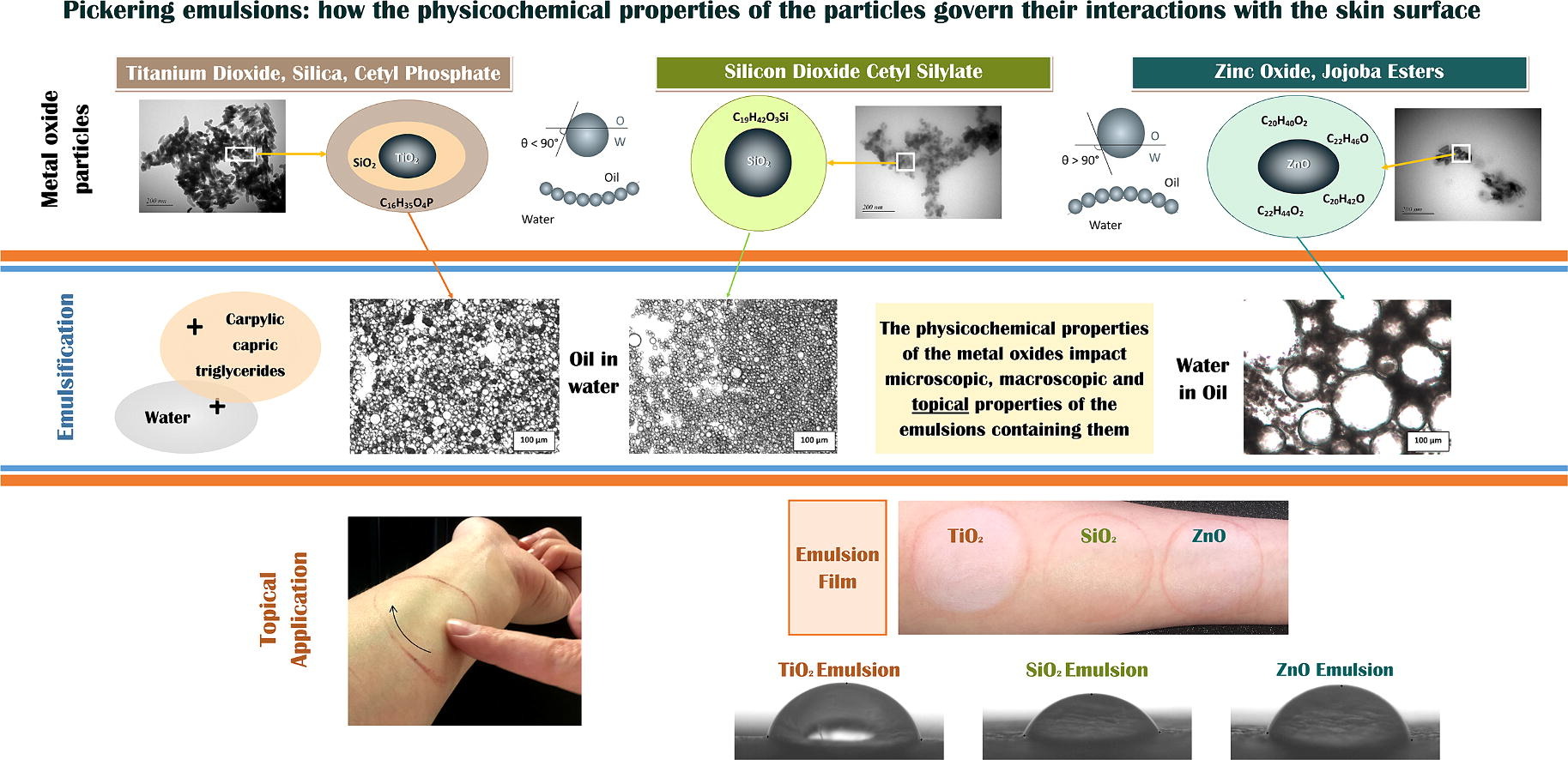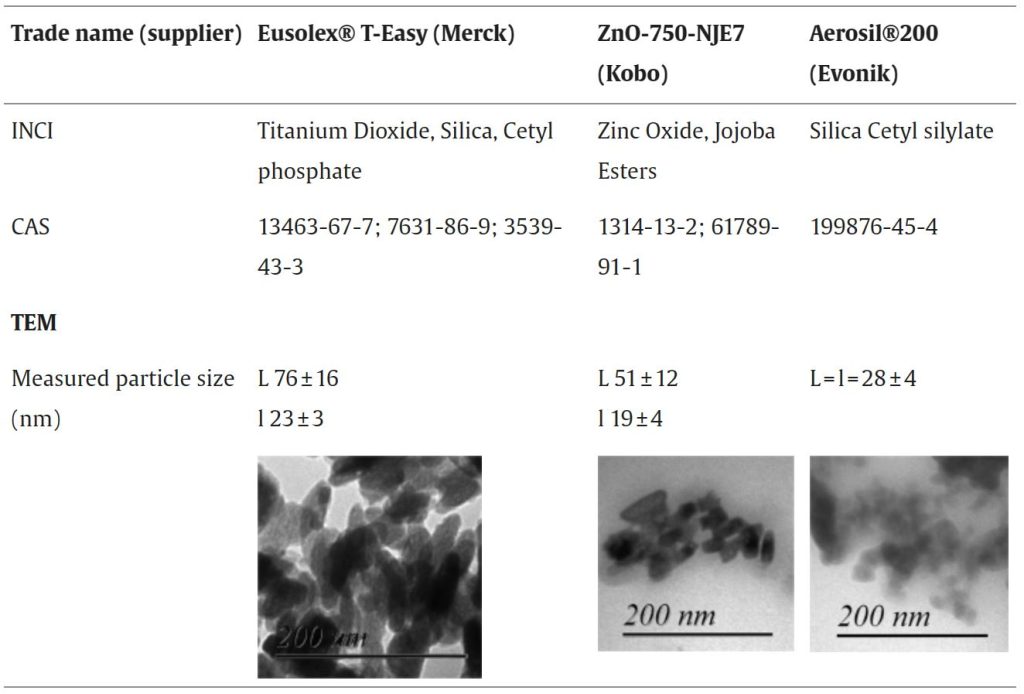Topical pickering emulsion versus classical excipients: A study of the residual film on the human skin

Abstract
The interest in Pickering emulsions is based on the possibility of replacing classical emulsifiers with solid particles. These emulsions are very attractive in the pharmaceutical field for their stability virtues and as a vehicle to deliver active ingredients. The study aimed to analyze the properties of the residual film of the Pickering emulsions on the human skin compared to conventional systems.
For this project, three types of solid particles were used: titanium dioxide, zinc oxide and silicon dioxide. All of them are capable of stabilizing the oil/water interface and thus forming totally emulsified systems. To create an emulsion of reference, a classical surfactant was used as an excipient. Complementary systems containing both particles and the emulsifier were also analyzed. Then, a combined approach between physicochemical and biometrological in vivo analysis was employed.
The study proved that Pickering emulsions stabilized by the metal oxides were distinct from the reference emulsion in terms of droplet sizes and organization, rheological and textural responses. Consequently, it impacted the properties of the residual film once the product was applied to the skin. The particle-stabilized emulsions formed a hydrophobic film counter to conventional excipients.
Also, the Friction parameter (or the roughness of the film) was directly linked to the quantity of the particles used in the formulation and their perception on the skin surface. The use of the particles blurs the glossy effect of the oil phase. Finally, it was observed that the appearance of the residual film was impacted by the type of the particle, namely TiO2 and ZnO particles.
Introduction
The interest in Pickering emulsions lies in the possibility of replacing conventional emulsifiers with solid particles (Binks, 2006, Pickering, 1907) by forming emulsions with a great stability potential towards coalescence and Ostwald ripening (Albert et al., 2019, Binks, 2002, Kargar et al., 2011). To study the ability of the solid particles to stabilize the interface of two non-miscible liquids, an important number of solid particles, of different characteristics, were described in the literature: chitosan (Asfour et al., 2017, Wang and Heuzey, 2016), cyclodextrin (Yang et al., 2017), starch (Marto et al., 2018, Rayner et al., 2014), iron oxides (Udoetok et al., 2016), titanium dioxide (Stiller et al., 2004), silica (Arditty et al., 2003, Binks and Yin, 2016, Binks et al., 2016, Frelichowska et al., 2009a, Torres et al., 2007), etc.
Some of these systems are showing great potential in pharmaceutics and dermocosmetics (Marku et al., 2012, Marto et al., 2015), namely for all-trans-retinol (Frelichowska et al., 2009a, Simovic et al., 2011) or caffeine (Frelichowska et al., 2009b) skin delivery through topical application. For example, the systems with silica particles are mainly focused on the emulsion’s capacity to play the role of the vehicles for the active ingredients and their diffusion in the Stratum Corneum (Frelichowska et al., 2013, Frelichowska et al., 2009a, Frelichowska et al., 2009b). The first work in this field was performed by Frelichowska et al. (Frelichowska et al., 2009b) demonstrating the first example of W/O silica particle-based Pickering emulsions for the transdermal delivery of caffeine. The better penetration of the actives was linked to improved adhesion of the Pickering emulsions to the skin surface coupled with a deep skin penetration of the stabilising silica nanoparticles, leading to enhanced drug release.
Harman et al. (Harman et al., 2019) discussed the recent developments in Pickering emulsions for biomedical applications for wound healing (Asfour et al., 2017) or for sunscreens (Binks et al., 2016, Binks and Yin, 2016, Marto et al., 2016b) application, where the emulsifying particles can be physical UV filters in combination with an encapsulated active agent, such as melatonin (Marto et al., 2016a). The authors also gave an important number of examples, proving that the choice of emulsifier and oil in the formulation can affect the permeability of the Pickering emulsions, their depth of penetration within the skin, and accumulation of particles, therefore affecting drug efficacy (Hu et al., 2018, Leclercq and Nardello-Rataj, 2016, Wang et al., 2017).
It is also important to question the use of solid particles on the microscopic and macroscopic properties of emulsions. The stabilization of the oil/water interface by the particles alone or combined with a classical surfactant compared to a conventional system changes the emulsion organization with a further impact on its textural properties (Terescenco et al., 2019). Furthermore, this impact strongly affects the spreading properties of the system, pointing to the interdependency between the use of the metal oxides and the applicative properties of the emulsions containing them. These texture properties are essential to ensure ease of application and an adequate distribution of the product on the skin.
The relationship between sensorial and physical characteristics of topical creams was recently studied by Ali et al. (A Ali et al., 2022a). The authors discuss the prediction of some sensorial attributes by means of rheology and frictional measurement. However, the study is based on only one type of starch particles, leaving the questioning on the behaviour of other Pickering-forming particles.
Consequently, in addition to information about the diffusion of the actives through the skin, it is also essential to investigate the interaction between the Pickering emulsion and the skin surface depending on the emulsion composition and the particle type used for the emulsion stabilisation.
To describe the residual film of the Pickering systems, one can take an example of the classical emulsions. However, even for the emulsions containing a usual surfactant, few studies deal with the “after application” phase and the fate of the product on the skin (Eudier et al., 2019a, Savary et al., 2019). Different instrumental methods can be envisaged to characterize the residual film left on the skin, such as biophysical methods like Corneometer®, Sebumeter®, Glossymeter® (Calixto et al., 2018, Lukic et al., 2012); infrared spectroscopy (Prasch et al., 2000, Wichrowski et al., 1995); contact angle measurements (Eudier et al., 2019b), or the combination of all these techniques (Faucheux et al., 2020). All these studies proved that the organisation and interaction of the ingredients inside the matrix have an impact on the properties of the residual film and, as a consequence, on the interaction with the human skin. The Pickering emulsions, being different in terms of composition from the classical emulsion, are expected to form a residual film with original properties. For this reason, the authors investigated the interactions between the emulsions and the human skin surface once applied, focusing on the residual film properties, and thus bringing novel information in the field of the applicative properties of the topical Pickering emulsions.
In this article, nine emulsions were studied, stabilised by different metal oxides, usual surfactants or a mixture of both. The work focuses on metal oxide particles like TiO2 and ZnO, poorly studied till now in the skin application field, contrary to the silica particles. According to (Peito et al., 2022), the only work on the Pickering topical application stabilised by titanium dioxide was performed by (Marto et al., 2016a, Marto et al., 2016b). The results of their work were potentially interesting; however, the formulation was highly charged in metal oxides, containing 35 % of solid particles (TiO2 and ZnO), contrary to this work, not exceeding 10 % of metal oxides, being more suitable for the pharmaceutical topical use.
The first aspect that was considered was the homogeneity of the residual film when the cream was applied to the skin. Depending on the particles selected and emulsion composition, the physicochemical properties of formulations, i.e. microstructure and viscoelastic properties, were studied and related to the spreading behaviour of Pickering emulsions. Finally, the last step consisted of the investigation of human skin’s role in the formation of the residual film. The skin is a biological system, extremely complex and with particular physicochemical properties. Therefore, to describe the skin–Pickering emulsion interactions in terms of spreadability, friction behaviour and residual film after application − a combined approach with in-vivo and in-vitro analyses at the skin and skin substitute surface was used.
Table 1. Trade name and the supplier of raw materials, INCI (International Nomenclature of Cosmetic Ingredients), CAS and the particle size, as well as the average particle size, measured by Transmission Electron Microscopy.
Download the full article as PDF here Topical pickering emulsion versus classical excipients
or read it here
Excipients mentioned in the study: Aerosil 200, titanium dioxide, silica, zinc oxide, silicon dioxide, starch, cyclodextrin
Daria Terescenco, Geraldine Savary, Celine Picard, Nicolas Hucher, Topical pickering emulsion versus classical excipients: A study of the residual film on the human skin, International Journal of Pharmaceutics, 2024, 124130, ISSN 0378-5173, https://doi.org/10.1016/j.ijpharm.2024.124130.
See our next webinar:
“Rethinking the development of controlled release formulations and manufacturing processes”
Date: 30th of April, Time: 3:00 pm (Amsterdam, Berlin)



